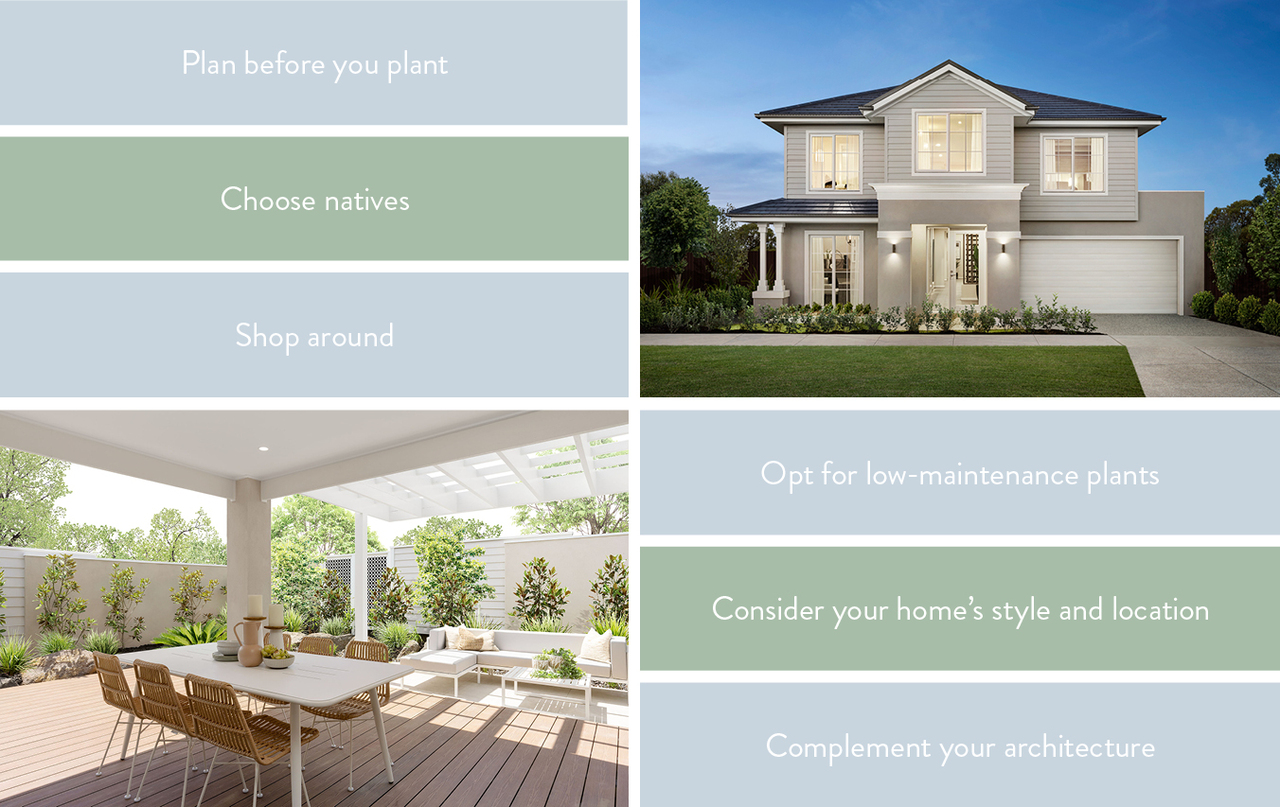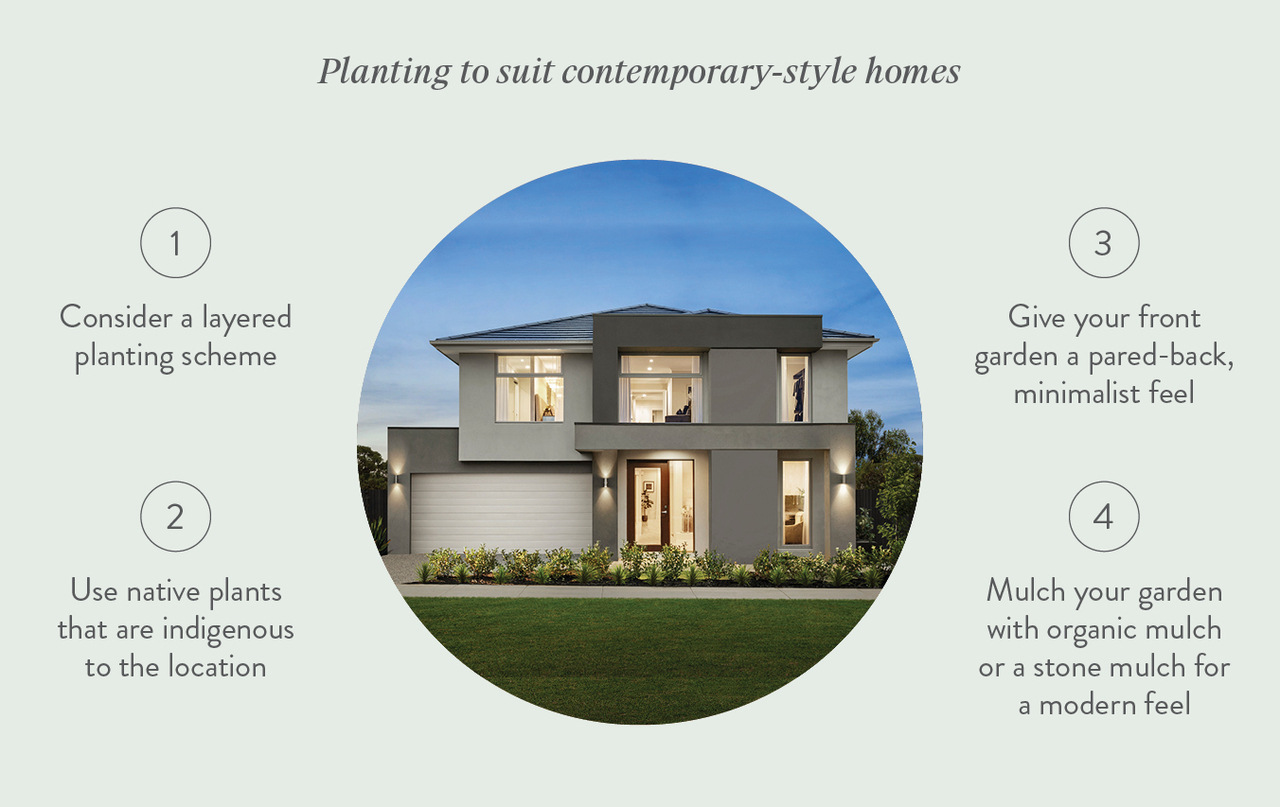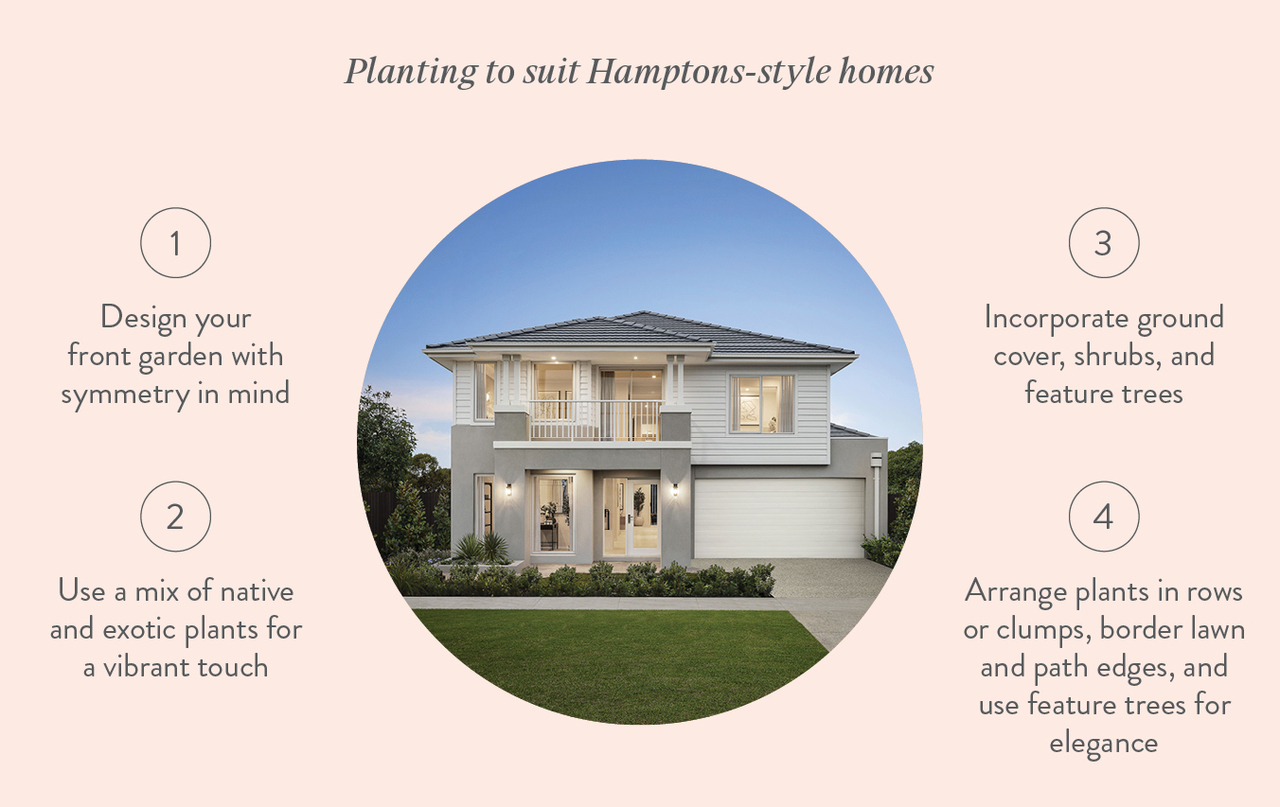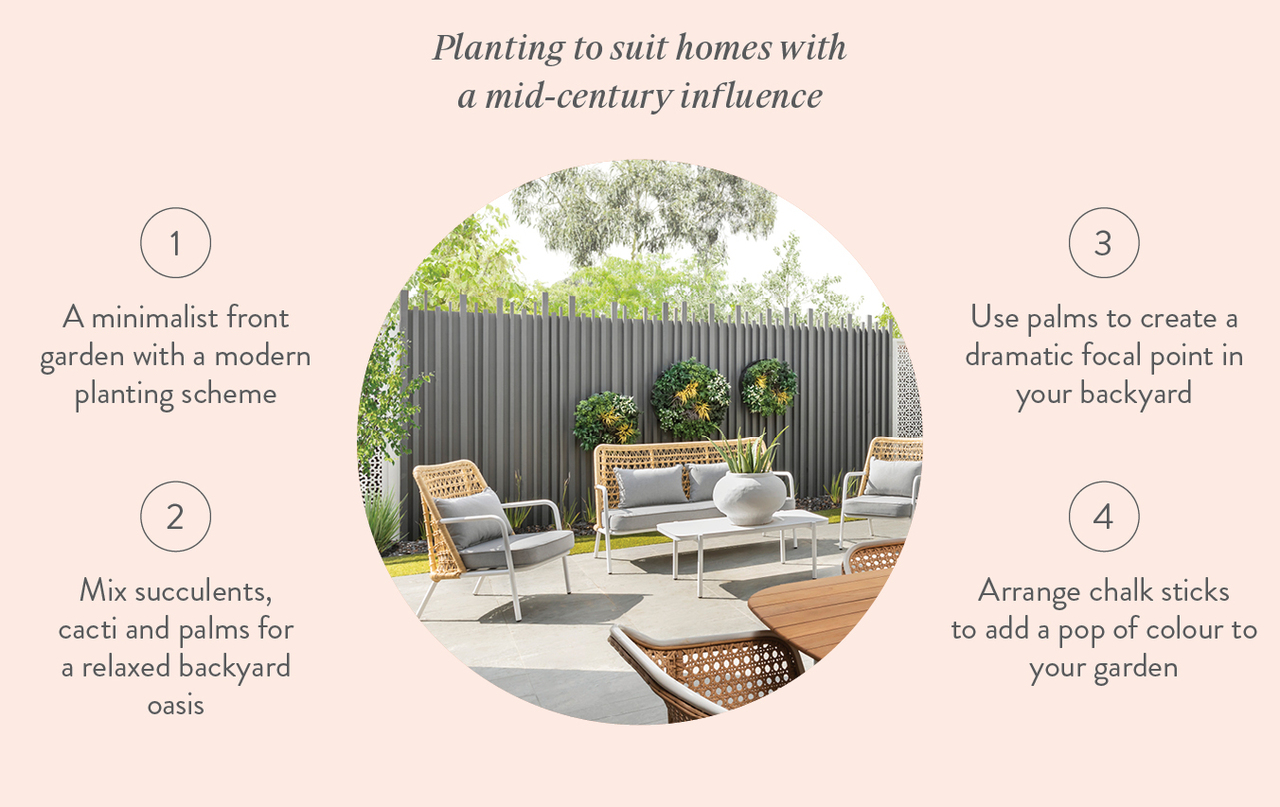Landscape Your Garden On A Budget
by Ricky D'Alesio, Senior Designer

With a little planning and some smart planting choices, you can create a beautiful garden without spending the earth, says Carlisle’s landscape design expert.
It’s an all too familiar story. You’ve put all your focus and funds into building your beautiful new home, and it’s left your landscaping budget virtually non-existent. If that sounds like you, don’t panic.
Mark Browning, landscape designer and principal at Mark Browning Landscape Design, who has designed over 500 stunning gardens in Carlisle display homes across Melbourne, shares his affordable landscaping tips for creating a spectacular garden without breaking the bank.
Mark Browning’s top tips for creating a spectacular garden

Before planting, strategise your landscape design. Choose some hardy native plants that suit Melbourne’s climate, and scout out good deals on affordably priced plants, supplies and feature items like a fire pit at your local garden store.
Expert tips and budget friendly options for creating your perfect outdoor space
Plan before you plant
Before you start your landscaping project, take some time to plan out your garden design. Consider factors like visual interest, sunlight exposure, soil type and water usage. By planning ahead, you can avoid costly mistakes and ensure your garden thrives. A well thought-out plan is key to landscaping on a budget, helping you maximise your resources to create a beautiful outdoor space without overspending.
Choose native plants for a low maintenance, cost effective and eco friendly garden
Opting for native plants is a smart choice for anyone looking for cheap landscaping ideas. Native plants are not only a cost effective solution for your garden, but also low maintenance and well-suited to Australia’s climate and soil conditions. These drought resistant plants, ornamental grasses, ground covers and shrubs can usually be purchased at a relatively low cost compared with other exotic species, and are a great way to add a pop of colour and texture to your garden, while attracting native wildlife such as birds and butterflies. They also require minimal watering, pruning and fertilising helping save money on water usage long term.
Shop around for low cost landscaping materials
When buying new plants and garden supplies, visit local nurseries, garden centres and online retailers to compare prices and find bargains. End-of-season sales and clearance events can be great places to achieve your cheap landscaping ideas, buying plants at discounted prices, as well as low cost garden tools and supplies needed for your landscaping. You can also consider using second hand furniture from thrift stores or garage sales and inexpensive materials like wooden pallets to create a raised garden bed, or river rocks to add visual impact to your garden bed - without the hefty price tag.
Consider your home’s style and location
Selecting the right plants for your home and lifestyle is important as they play a huge role in both the cost and upkeep of your landscaping project. You’ll want plants that not only add visual appeal to your home, but will cope with Melbourne’s typically hot summers, cool winters and rain.
If you lead a busy life, as many people do today, your landscaping ideas should realistically reflect the amount of time you can dedicate to maintaining your own backyard. Choosing perennial plants and drought tolerant plant varieties are cost effective ways to keep your garden looking its best with minimal effort. Incorporating elements such as raised flower beds, stepping stones and climbing vines can add visual interest without being time consuming to maintain.
When planning your entire project, consider the square footage of your lawn area and garden beds, and look to incorporate things like water features or fire pits that create a focal point in your backyard landscaping without requiring constant attention.
Use eco friendly plants
Using local ecosystem friendly plants will not only support plant health but also contribute positively to the environment. Additionally, think about integrating other materials like gravel or mulch to reduce the need for frequent weeding and watering, ensuring your garden remains a beautiful, manageable space year-round.
Complement your architecture
“You’ll want your planting scheme to reflect the style of your home, and in particular your facade,” says Browning. Here are four high-impact, budget-friendly planting schemes that Browning recommends for some of Australia’s most popular architectural styles, which will work a treat with your new Carlisle home, depending on the facade you choose.

Crafting contemporary curb appeal? Try a layered planting scheme with native ground covers, strap leaf plants, and bold succulents. Choose low-maintenance, drought-tolerant plants for hassle-free upkeep and modern allure
Planting to suit contemporary-style homes
“For contemporary homes, consider a layered planting scheme consisting of perennial plants, ground covers, strap leaf plants, shrubs, succulents, screening plants and trees for privacy.
“I like to use native plants that are either indigenous to the location or engineered to grow in similar conditions, and succulents with a bold form. This approach also promotes water conservation, which is ideal for homeowners looking to save money on water bills,” explains Browning.
Maximise space and functionality
“In both large and small backyards, strategic planning is key. Grouping plants of varying heights and textures can create visual interest and make the space feel more expansive. You can often get away with your front garden having a pared-back, minimalist feel, while your rear garden can be more relaxed to reflect how your family uses the space,” says Browning.
“For additional functionality, incorporate additional seating areas using sleek, contemporary furniture. This not only provides space to relax and entertain but also complements the modern aesthetic of your home,” Browning concludes.
Enhance with sustainable features
“To prevent soil erosion and promote water conservation, consider installing retaining walls using natural stone or timber. Lining your plant beds with landscape fabric can also reduce weed growth and maintain soil moisture. Adding a simple water feature can serve a striking focal point, creating a serene atmosphere for your outdoor space,” says Browning.
“Adding low-maintenance plants such as a White Correa Shrub, paired with a strap leaf plant such as Nyalla Lomandras, and a succulent like a Dragon tree are easy for novice gardeners to grow in sunny and open positions and are all drought-tolerant once established. I like to arrange the Correas and Lomandras in clumps of between five and seven, and use a Dragon Tree as a striking, stand-alone feature. These plants are most cost effective, helping you to achieve the cheap landscaping ideas that you had initially planned for.
“To maximise growing success, mulch all garden areas with an organic mulch. For contemporary homes, you might also want to use gravel and stone mulches, which have a modern feel and will set off these plants beautifully, while keeping garden areas damp and cool,” he says.

For Hamptons-style facades, think lush greenery. Mix native and exotic plants for a symmetrical, formal front garden. Try Asiatic jasmine, snow maiden Indian hawthorns, and white crepe myrtles for a timeless, low-maintenance landscape.
Planting to suit Hamptons-style homes
“When it comes to landscaping, Hamptons-style homes call for a medley of rich green tones – for example, a mix of ground covers, strap leaf plants, shrubs, screening plants for privacy and trees for shading and structural presence.”
“Regular lawn care and attentive pest control are essential to keep your garden flourishing. Using natural pest deterrents and maintaining healthy soil will ensure your plants remain vibrant throughout the seasons,” Browning adds.
Creating symmetry and structure
“Design your front garden to be formal to match your home’s façade, with an emphasis on symmetry,” says Browning.
“I like to see flower beds filled with plant perennials alongside a mix of native, exotic plants and features trees with deep green tones.When it comes to ground cover, I favour Asiatic Jasmine, paired with shrubs such as Snow Maiden Indian Hawthorns, and feature trees like White Crepe Myrtles. All add timeless beauty and are relatively easy to maintain.
“I like to arrange the Indian Hawthorns in rows or clumps, the Asiatic Jasmine as border plantings on the lawn and path edges, and the Crepe Myrtles as either one-off feature trees or, if space permits, avenue plantings. All these plants are exotics and grow well in open, sunny positions in a range of soil types. Use an organic mulch to enhance growing success,” he says.
Incorporating functional features
“Introduce cozy lawn areas for children to play or for hosting gatherings. Integrating stepping stones can create charming pathways connecting different sections of your garden, while a classic water feature, such as a small fountain, can serve as a tranquil centrepiece,” he adds.

Complement your traditional facade with a tailored planting scheme that incorporates classic favourites, like big blue Liriopes, Miss Muffet Pittosporums, and Miles Choice Bay Trees for a formal yet inviting look.
Planting to suit traditional or provincial-style homes
“Homes with a classic or provincial aesthetic call for a formal landscaping scheme with plenty of structure,” says Browning. “When landscaping traditional homes, I like to use a mix of native and exotic plants with some natural or clipped formality, plus features trees.”
Structured and elegant design
“My go-tos include strap leaf plants such as big blue Liriopes, shrubs such as Miss Muffet Pittosporums, and screening plants like Miles Choice Bay Trees. All these plants require some maintenance, such as pruning to shape them once or twice annually, and regular fertilising. Once established, they are fairly drought-tolerant, but will require extra watering in dry periods, making them a better pick for experienced gardeners.
“I like to arrange the Liriopes in clumps en masse beneath shade-providing trees, the Pittosporums in clumps of five to seven, with low plantings between and around them. I use the Bay Trees along fence lines for screening and privacy.
“All these plants are exotics and grow well in different soil types. The Liriopes grow well in semi-shaded spots, while the Pittosporums and Bay trees do well in open, sunny positions. Use an organic mulch throughout the garden to maximise growing success,” he says.
Enhance with classic features
“Incorporating elements like angled pavers can define walkways and add a classic touch to your landscape,” Browning suggests.
“A well-manicured lawn is a staple of traditional landscaping. Regular lawn care, including mowing, fertilising and watering will keep your home looking pristine. For added elegance, consider adding a decorative water feature or old furniture within your garden.”

For facades with a mid-century influence, capture the modernist, Palm Springs spirit by incorporating succulents, cacti, palms, and gravel or stone mulch in your front yard planting scheme.
Planting to suit homes with a mid-century influence
“For homes with a mid-century influence, opt for a modern planting scheme with a strong emphasis on modernism. Your front gardens should be more minimalist, while your backyard can be more relaxed,” says Browning.
Modern and minimalist
“For this look, I like to use a mix of succulents, cacti and palms to mimic Palm Springs landscapes.
“Ground covers I’d recommend include Trident Blue Chalk Sticks, a shrub-like cacti such as Golden Barrel Cactus, and Cabbage Fan Palms. All these plants are low-maintenance, extremely drought-tolerant once established, and easy for novice gardeners to grow – albeit the golden barrels are very thorny.
“I like to arrange the Chalk Sticks as border plants beside paths and the Golden Barrels in open garden areas, with the palms used as standalone features.
“Gravel and stone mulches will set off these plants beautifully, while keeping your garden moist and cool,” he says.
Ensuring Plant Health and Longevity
“Proper soil preparation and ensuring adequate drainage holes in planting areas are essential for maintaining plant health, especially for succulents and cacti. Regular monitoring for pests and implementing natural pest control measures will keep your plants thriving,” Browning concludes.
Three beautiful, budget friendly plants to add to your landscape
Hitting the garden centre sometime soon to find plants to achieve your cheap landscaping ideas? Here are Browning’s top picks for hardy, beautiful and affordably priced plants to save money, so keep an eye out!
Yareena Creeping Boobialla
This native hybrid ground cover is specially engineered to suit our climate. It’s a great border plant that will spread to large areas, with foliage that ranges from green to purplish, and small white flowers that occur year-round.
Plum Gorgeous
This compact shrub has stunning burgundy-purple foliage and pink flowers. It grows to around 1.5 metres high and 2 metres side, making them a perfect focal point within garden containers.
Kingsdale Tussock Grass
This native grass is engineered to be smaller and tuftier than its parent, common tussock grass. I love the grey grassy fronds and summertime seed heads, which add texture to any landscape design.
Plants to avoid in your garden
As for the plants to avoid, Browning says: “Bamboo, especially varieties with invasive root systems, and Yaccas, which can be a safety hazard with their thorny leaf tips. I’d also limit the number of tropical plants you use as they don’t cope well with our bitter winter winds.
And, if in doubt, ask a landscape designer, advises Browning - “They can tell you which plants will grow best in your home’s climate,” advises Browning.
Head out to one (or more) of our display homes across Melbourne and Geelong and see Browning’s stunning garden landscaping for yourself – it’s guaranteed to fuel your design thinking when it comes to your own front and backyard.
Or if you can’t make it out to our display villages, explore the huge inspiration gallery on our website, and the virtual tours of all of our past and present display homes.

Ricky D'Alesio
Senior Designer
Ricky is passionate about all things design, and loves creating floor plans to suit the needs of all types of customers. His expertise spans across all areas of design, from space planning and ensuring structural integrity to interior floor plans and facade design.
Learn more about Ricky D' Alesio